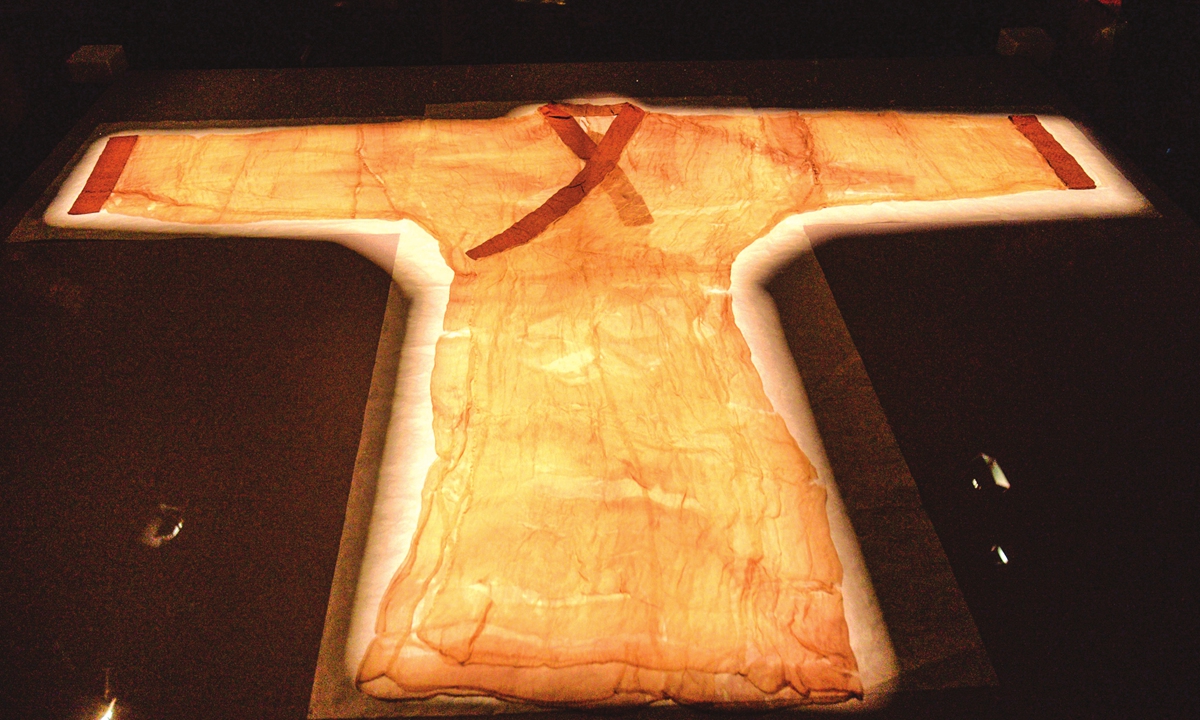ARTS / ART
Dedicated research brings 2,000-year-old Han Dynasty silk garment back to life
Thin as a cicada’s wing

The Han Dynasty (206BC-AD220) Plain Unlined Gauze Gown Photo: IC
Editor's Note:
Carrying the genes and spirit of a nation, cultural relics and heritages are irreplaceable resources for a thriving civilization. A huge number of Chinese relics have become more popular over the past 10 years and allowed people from around the world to get to know Chinese culture better. The Global Times will feature a number of these "star" artifacts in this series, to make these cultural relics come alive.
As President Xi Jinping has said, Chinese civilization, together with the colorful civilizations of other countries, should provide mankind with proper spiritual guidance and a strong spiritual impetus.
Amongst the many Chinese historical relics that are "hefty" both in terms of size and cultural significance, the Plain Unlined Gauze Gown, a silk garment discovered in the Mawangdui Tomb in Changsha, Hunan Province, is uncannily lightweight - weighing only 49 grams - yet its importance cannot be underestimated as it represents the peak of silk weaving during the Han Dynasty (206BC-AD220).
First discovered in 1972, this relic waited for those who could replicate it for 48 years. Finally, after decades of research, the experts at the Nanjing Yunjin Brocade Research Institute in Jiangsu Province were able to complete a 1:1 copy of this valuable treasure.
The replica is on display in the Hunan Museum, where it helps people learn more about China's silk history and inspires designers in their own works.
In 2019, the Nanjing Yunjin Brocade Research Institute successfully created a replica of the Han Dynasty Plain Unlined Gauze Gown. Weighing at 49 grams, the thin garment can be folded and stored in a container the size of a matchbox, just like the original.
Jian Mingwei, the director of the institute, explained to the Global Times that in order to attain silk threads as thin as the ones used during the Han Dynasty, they tried to control the sleep routine of the silkworms to follow the "three-sleep" pattern used by the ancient dynasty.
"Most modern silkworms produce heavier silk that does not meet the standards needed to replicate this understated yet extremely delicate item," Jian noted.
The Chinese idiom "thin as a cicada's wing" is probably the most accurate description of this garment. A total of 160 centimeters in length, it is still one of the world's most lightweight items of clothing as the silk weighs only 15.4 grams per square meter. The fabric is so sheer that it can still be seen through after being folded more than 10 times.
Compared to other Chinese brocade garments such as the colorful and diverse Nanjing brocade, also known as yunjin (lit: cloud brocade), the beauty of the gauze gown lies in its "plainness."
Although the garment was originally transparent, after being buried for centuries the silk had turned to a light brown tea color. For the replica, researchers carried out several dyeing experiments before they finally came up with a "black tea" color that looked most akin to the ancient garment.
"Many experts believe that colorless sheer garments were worn as an extra layer over finely decorated robes to create a hazy effect. This also shows Chinese people's desire for understated aesthetics," Fang Junyi, a Chinese fashion researcher, told the Global Times.
Currently stored at the Hunan Museum, the Plain Unlined Gauze Gown was discovered in the Mawangdui tomb belonging to Xin Zhui, the marquise of Dai. The garment also has a "sister" piece discovered at the same time that is even lighter. This latter has been described as "smoke thin" by experts.
Spending 13 years carrying out research and creating the final replica, Jian told the Global Times that Chinese silk and brocade culture is profoundly diverse but also entwined. This latter fact enabled the experts of Nanjing brocade - a 1,600-year-old brocade tradition known for its intricate patterns and bold use of colors - to use their skills to restore the gauze gown.
Embracing creativity
"Even though people no longer wear glorious robes every day like they did 2,000 years ago, we still need creativity to design clothes for people today," Jian noted.
Lin Chunying is a young designer of hanfu, the traditional clothing of the Han ethnic group, who was inspired by the ancient sheer gown to create "portable hanfu" that people can wear every day.
She observed that while hanfu has become a much-loved fashion choice for many young Chinese looking to go out and pose for fun photos, but due to the clothing's layered design, these dresses are not suitable nor convenient to act as everyday wear, especially during the summer. With the lightest weighing only 24 grams, Lin's design can also fit into a matchbox. The modern designer has also diversified the ancient garment's plain beauty by using watered gauze fabrics with dyed floral patterns in pink and blue in order to add a touch of color.
"My collection, called 'Sheer Moment' was inspired by China's traditional silk culture. However, this collection includes clothing and accessories such as suits, silk bags and one-piece dresses that my customers can wear every day to work," Guan Yishu, another fashion designer inspired by the ancient art said. "When I posted my works on Instagram, I got a message that a trendy pop culture brand wanted to collaborate. I guess that's how Chinese culture can continue to be inspiring."
Born on the Island of Taiwan, Jian said he was drawn to Chinese silk culture as a child. He mentioned that he is gearing up to create some "crossover" projects that will allow people to see Chinese silk aesthetics on makeup tins, bus cards and even digital skins people can purchase in online games.
"The current popularity of the 'Chinese trend' means this is a good time for us to pass on our Chinese memories and destinies," Jian noted.

